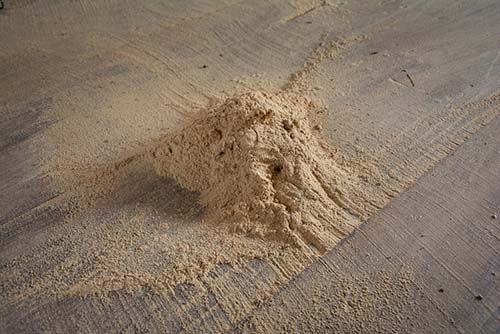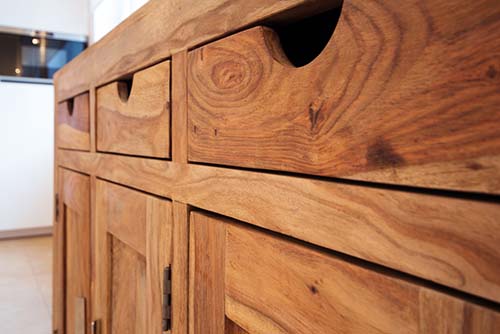
Wood-boring beetles, such as powderpost beetles, common furniture beetles, and old house borers, are small pests that can damage wood in and around the home. These pests can be beneficial to forest eco-systems, as they kill weak trees which allows new trees to grow, but are not beneficial when they are in an occupied home or commercial building.
Use this guide to help find wood-boring beetles, their larvae, and signs of beetles. Knowing where wood-boring beetles are or have been will indicate where you should treat to remove the pests.
Not sure if you have wood-boring beetles? Read our wood-boring beetle identification guide to be sure.
Click one of the topics below to learn about the signs of wood-boring beetles, or continue reading for a guide on where to find wood-boring beetles.
Holes and Tunnels

Adult beetles lay their eggs in cracks and holes in wood and the larvae, known as "woodworms" slowly eat the wood when they burrow their way out as they are growing into adults. It can take a few months to a few years for a wood-boring beetle to burrow out of a piece of wood. This burrowing creates holes and tunnels in the wood.
The most common signs of wood-boring beetles are holes and tunnels in wood. Visible holes typically indicate that the larvae have already left the wood.
The size of the emergence holes vary depending on the type of wood-boring beetle. Powderpost beetles leave holes no larger than 1/8 inch in diameter while common furniture beetles leave holes up to 1/2 inch in diameter.
Wood Powder

A sign of a wood-boring beetle infestation is wood powder. Some woodworms, like those of powderpost beetles, can turn wood into fine powder if given enough time. Powder is often found near wood where holes and tunnels have also been found.
Fresh wood powder is white and does not clump while old wood powder is yellow and clumpy. Fresh powder can be a sign of an active infestation while old powder may indicate that the beetles have already left the nearby wood.
New Construction and Renovation

Wood-boring beetles can be found in new construction, sometimes even 3-5 years after the building has been completed! Unbeknownst to the construction crew, infected wood may be used during a new house build, a renovation, or the construction of a commercial building. Woodworms may be inside the wood, only to emerge months or years after construction has ended.
Humid Areas

Wood-boring beetle infestations are more likely to occur in areas of high humidity. With most homes and buildings having central air-conditioning, a new infestation is unlikely to occur in occupied, temperature-controlled rooms.
Check crawlspaces, basements, and attics for holes, tunnels, wood powder, and woodworms and beetles themselves as these areas are often not temperature-controlled.
Furniture and Home Decor

Some wood-boring beetles may infest furniture. Inspect any wooden furniture or home decor brought into your home for emergence holes, especially if wood powder appears nearby.
If you see signs of wood-boring beetles in your home or the beetles themselves, you can get rid of them. Read our guide on how to get rid of wood-boring beetles to learn how. Click the right arrow below to learn more.



